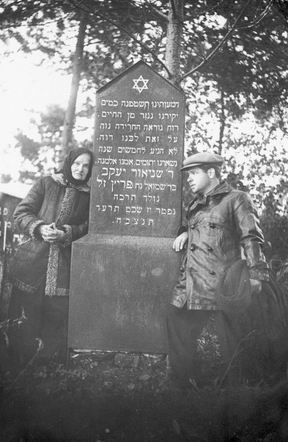
|
Rochel-Leah beside his father's grave
|
[Pages 89-91]
The Hevra Kadisha - the burial society - kept the Pinkas - records of those who had died. The elders of the shtetl used to relate that the register was started when the cemetery was established in the shtetl, that is, from the beginning of Jewish settlement in Dusiat.
When a person died at home the body was placed on the floor. Lighted candles were placed at the head of the deceased, and the members of Hevra Kadisha sat around the body and recited psalms in shifts, until the funeral. It was accepted practice to have the funeral the day after the person's departure. “Accompanying the dead” is a mitzvah, so there were always volunteers for the burial society, which arranged the funerals and saw that there were people to recite psalms. Omrey Tehilim (“psalms reciters”) used to sit around a long table in the synagogue and study mishnayot, parts from the Talmud.
I remember the woman who sewed the shrouds – cloths … She also did the
”Tahara” – (”purification”, washing of the corpse).
All the residents of the shtetl used to accompany the deceased to the synagogue. The rabbi stood and gave a eulogy for the deceased – sometimes long and sometimes short – and from there they continued to the cemetery. People walked in front of the wagon carrying the bier and recited psalms, and others walked among the people in the funeral procession with charity boxes, calling: “charity rescues from death”.
The deceased was buried in a coffin, and under the head they placed a bag of earth from Eretz Yisrael, and in each hand they placed a small stick. I remember that as a child I was told that they placed two forks in the deceased's hands, to make it easier for him or her to rise at the “resurrection of the dead”.
Cohanim are not allowed to enter the cemetery, and they remained standing outside the fence.
I remember that the gravediggers used to have a drink before the burial, in order to build up their strength. Shlomo Shapira was the chief gravedigger. One of the children once asked: “Who will bury Shlomo when he dies?”…
After the funeral the accompaniers would purify themselves by ritually washing their hands, and because it was forbidden to enter the house with wet hands, as that meant they were still perhaps impure, we used to dry them on the fences of the Gentiles' yards. There it was permitted to get rid of the impurity…
We were overcome by fear in the vicinity of the cemetery. They said that the dead rose at night and walked among the trees. For that reason we were also afraid to be in the vicinity of the synagogue at night, because they said that at midnight the dead came to pray…
I remember one winter night the laundry that had been hung up near the synagogue froze from the cold – a frightening sight. A pair of lovers passed by there and suddenly a weird figure began to move. They were frightened out of their wits for fear that the dead person was following them.
|
Yitzchak Poritz and his mother Rochel-Leah beside his father's grave
|
|
Rivka, Esther, Avraham and Itale beside the grave of their brother, Kehat Orlin
Kehat died of smallpox at the age of twenty. There were two more such cases in Dusiat. |
|
|
JewishGen, Inc. makes no representations regarding the accuracy of
the translation. The reader may wish to refer to the original material
for verification.
JewishGen is not responsible for inaccuracies or omissions in the original work and cannot rewrite or edit the text to correct inaccuracies and/or omissions.
Our mission is to produce a translation of the original work and we cannot verify the accuracy of statements or alter facts cited.
 Dusetos, Lithuania
Dusetos, Lithuania
 Yizkor Book Project
Yizkor Book Project
 JewishGen Home Page
JewishGen Home Page
Copyright © 1999-2026 by JewishGen, Inc.
Updated 5 Sep 2008 by LA